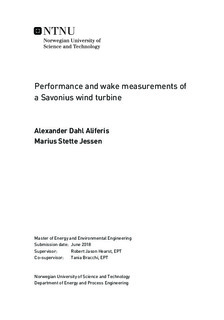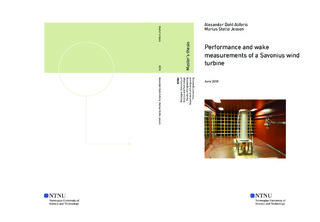| dc.description.abstract | In this study, the performance, drag and wake characteristics of a vertical axis Savonius
wind turbine are investigated experimentally. The turbine is drag driven and has a helical
configuration, making the top rotated 180 degrees relative to the bottom. All experiments were conducted in the wind tunnel at the Norwegian University of Science and Technology. The rotor wake was captured using two Cobra probes produced by Turbulent Flow Industries (TFI). These are 4-holed dynamic pressure probes capable of measuring all three velocity components in turbulent conditions. Both performance and wake measurements were conducted in four different inflow conditions, using Reynolds numbers of Re = 1.6*10E5 and Re = 2.7*10E5 and turbulence intensities of 0.6% and 5.7%.
The efficiency of the turbine was found to be highly dependent on the Reynolds number of
the incoming flow. In high turbulent inflow, the efficiency was only reduced in the case of
high Reynolds number. Hence, greater levels of turbulence results in a weaker Reynolds
number dependency of the rotor performance. The drag of the turbine was shown to be
independent of the turbines rotational speed over the range tested, and it was slightly lower
in high turbulent inflow.
The wake was captured for the described inflow conditions in both optimal and sub-
optimal operating conditions by varying the rotational speed of the turbine. Measurements were conducted in a horizontal plane at the center height of the turbine, spanning 2.3 turbine diameters in both lateral directions relative to the turbine center-line, and up to 11.6 diameters downstream of the turbine. Results show an asymmetrical wake formation in optimal operating conditions where the velocity deficit is greatest behind the returning turbine blade. In sub-optimal conditions, the wake is more symmetric. Regarding levels of turbulent kinetic energy in the wake, a proportionality with the inflow turbulence intensity
was observed. The levels of lateral entrainment in the far wake (above 8 diameters downstream) are found to increase in high turbulence, This leads to more turbulent mixing and faster recovery of the far wake. In low Reynolds number flow, higher inflow turbulence intensity increase the wake width compared to the case of almost uniform inflow. This is in contrast to the wakes of horizontal axis wind turbines. The opposite effect was however observed in high Reynolds number flow. Based on the findings from the wake measurements, some recommendations on where to place supplementary turbines. | |

